Correct Answer

verified
Correct Answer
verified
Multiple Choice
Which of the following is a secondary alkyl halide?
A) 1-Bromo-2-methylpropane
B) 2-Bromopropane
C) 1-Bromobutane
D) 2-Bromo-2-methylpropane
F) A) and B)
Correct Answer

verified
Correct Answer
verified
Multiple Choice
Predict the major product for the following SN1 reaction. 
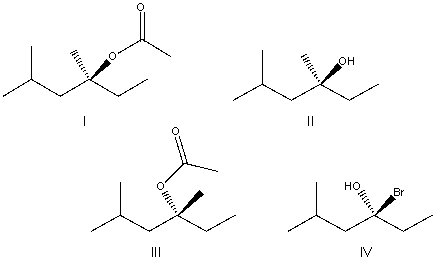
A) I
B) II
C) Both I & III
D) Both II & IV
E) None of these
G) C) and D)
Correct Answer

verified
Correct Answer
verified
Multiple Choice
Which of the following is the correct mechanism for the elimination reaction of 2-bromo-2,3-dimethylbutane with methoxide? 
A) I
B) II
C) III
D) IV
F) B) and C)
Correct Answer

verified
Correct Answer
verified
Essay
Draw the mechanism and product for the following E2 reaction. 
Correct Answer

verified
Correct Answer
verified
Multiple Choice
Which of the following is most reactive in an E1 reaction? 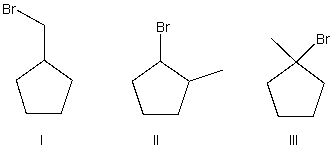
A) I
B) II
C) III
E) B) and C)
Correct Answer

verified
Correct Answer
verified
Essay
For the following dehydration, draw the structure of the intermediate carbocation. 
Correct Answer

verified
Correct Answer
verified
Multiple Choice
Which of the following is a substitution reaction? 
A) I
B) II
C) III
D) IV
F) A) and D)
Correct Answer

verified
Correct Answer
verified
Multiple Choice
Predict the product for the following reaction. 
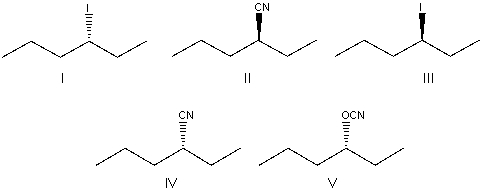
A) I
B) II
C) III
D) IV
E) V
G) B) and E)
Correct Answer

verified
Correct Answer
verified
Multiple Choice
Predict the product for the following reaction. 

A) I
B) II
C) III
D) IV
E) I and II
G) C) and D)
Correct Answer

verified
Correct Answer
verified
Multiple Choice
Predict the major product for the following SN1 reaction. 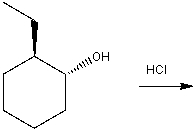

A) I
B) II
C) III
D) IV
E) V
G) A) and C)
Correct Answer

verified
Correct Answer
verified
Multiple Choice
Consider the following SN2 reaction,  Assuming no other changes, what is the effect on the rate, if the concentration of 1-chloro-3-methylbutane is doubled?
Assuming no other changes, what is the effect on the rate, if the concentration of 1-chloro-3-methylbutane is doubled?
A) No effect
B) It would double the rate
C) It would triple the rate
D) It would increase four times
E) It would reduce by half
G) D) and E)
Correct Answer

verified
Correct Answer
verified
Essay
Draw the isomer of 2-bromo-1,1,3-trimethylcyclohexane that would be more reactive in an E2 elimination.
Correct Answer

verified
 _TB4454_00...
_TB4454_00...View Answer
Show Answer
Correct Answer
verified
View Answer
Essay
Draw the E isomer of 2-methyl-3-heptene.
Correct Answer

verified
Correct Answer
verified
Multiple Choice
Which of the following is a secondary alkyl halide?
A) (CH3) 2CHCH2Cl
B) (CH3) 2CClCH2CH3
C) (CH3) 2CHCHClCH3
D) (CH3) 2CHCH2CCl(CH3) 2
F) A) and D)
Correct Answer

verified
Correct Answer
verified
Essay
For the following reaction, label the nucleophile, electrophile, and leaving group. 
Correct Answer

verified
Correct Answer
verified
Multiple Choice
Which of the following is an elimination reaction? 
A) I
B) II
C) III
D) IV
F) B) and C)
Correct Answer

verified
Correct Answer
verified
Multiple Choice
Predict the product for the following SN1 reaction. 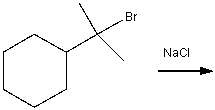

A) I
B) II
C) III
D) IV
F) B) and C)
Correct Answer

verified
Correct Answer
verified
Multiple Choice
Which of the following is a substitution reaction? 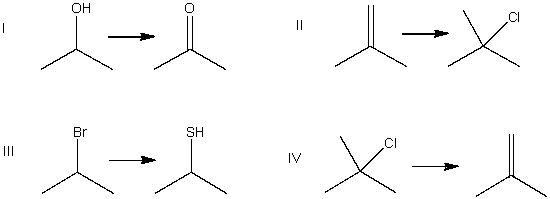
A) I
B) II
C) III
D) IV
F) C) and D)
Correct Answer

verified
Correct Answer
verified
Multiple Choice
Consider the following SN2 reaction,  Assuming no other changes, what is the effect on the rate, if the concentration of NaN3 is tripled?
Assuming no other changes, what is the effect on the rate, if the concentration of NaN3 is tripled?
A) No effect
B) It would double the rate
C) It would triple the rate
D) It would increase four times
E) It would increase the rate six times
G) A) and E)
Correct Answer

verified
Correct Answer
verified
Showing 141 - 160 of 224
Related Exams